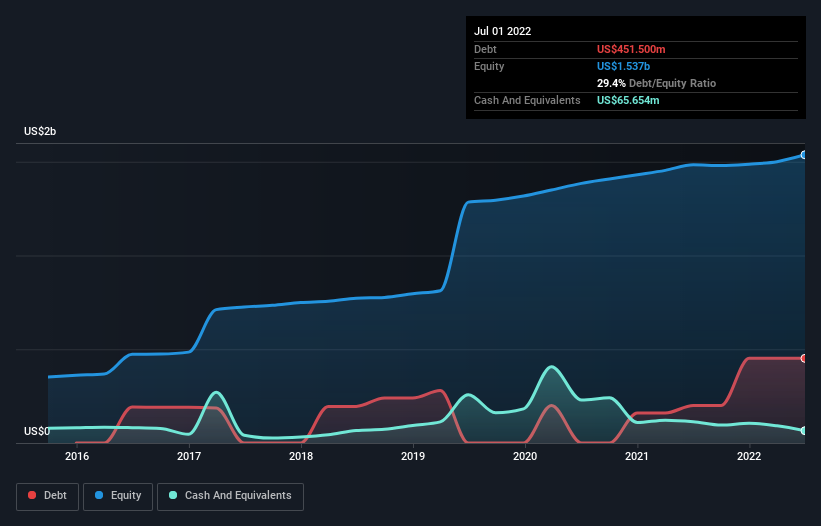Warren Buffett famously said, 'Volatility is far from synonymous with risk.' So it might be obvious that you need to consider debt, when you think about how risky any given stock is, because too much debt can sink a company. Importantly, Mercury Systems, Inc. (NASDAQ:MRCY) does carry debt. But should shareholders be worried about its use of debt?
Why Does Debt Bring Risk?
Debt is a tool to help businesses grow, but if a business is incapable of paying off its lenders, then it exists at their mercy. Part and parcel of capitalism is the process of 'creative destruction' where failed businesses are mercilessly liquidated by their bankers. However, a more frequent (but still costly) occurrence is where a company must issue shares at bargain-basement prices, permanently diluting shareholders, just to shore up its balance sheet. Of course, debt can be an important tool in businesses, particularly capital heavy businesses. When we think about a company's use of debt, we first look at cash and debt together.
What Is Mercury Systems's Net Debt?
As you can see below, at the end of July 2022, Mercury Systems had US$451.5m of debt, up from US$200.0m a year ago. Click the image for more detail. However, because it has a cash reserve of US$65.7m, its net debt is less, at about US$385.8m.

How Strong Is Mercury Systems' Balance Sheet?
Zooming in on the latest balance sheet data, we can see that Mercury Systems had liabilities of US$193.9m due within 12 months and liabilities of US$572.4m due beyond that. On the other hand, it had cash of US$65.7m and US$447.9m worth of receivables due within a year. So its liabilities total US$252.8m more than the combination of its cash and short-term receivables.
Given Mercury Systems has a market capitalization of US$2.68b, it's hard to believe these liabilities pose much threat. Having said that, it's clear that we should continue to monitor its balance sheet, lest it change for the worse.
We use two main ratios to inform us about debt levels relative to earnings. The first is net debt divided by earnings before interest, tax, depreciation, and amortization (EBITDA), while the second is how many times its earnings before interest and tax (EBIT) covers its interest expense (or its interest cover, for short). This way, we consider both the absolute quantum of the debt, as well as the interest rates paid on it.
Mercury Systems's net debt to EBITDA ratio of about 2.4 suggests only moderate use of debt. And its commanding EBIT of 12.4 times its interest expense, implies the debt load is as light as a peacock feather. Importantly, Mercury Systems's EBIT fell a jaw-dropping 32% in the last twelve months. If that earnings trend continues then paying off its debt will be about as easy as herding cats on to a roller coaster. When analysing debt levels, the balance sheet is the obvious place to start. But it is future earnings, more than anything, that will determine Mercury Systems's ability to maintain a healthy balance sheet going forward. So if you want to see what the professionals think, you might find this free report on analyst profit forecasts to be interesting.
Finally, a company can only pay off debt with cold hard cash, not accounting profits. So the logical step is to look at the proportion of that EBIT that is matched by actual free cash flow. In the last three years, Mercury Systems's free cash flow amounted to 28% of its EBIT, less than we'd expect. That's not great, when it comes to paying down debt.
Our View
Mercury Systems's EBIT growth rate and conversion of EBIT to free cash flow definitely weigh on it, in our esteem. But the good news is it seems to be able to cover its interest expense with its EBIT with ease. We think that Mercury Systems's debt does make it a bit risky, after considering the aforementioned data points together. Not all risk is bad, as it can boost share price returns if it pays off, but this debt risk is worth keeping in mind. When analysing debt levels, the balance sheet is the obvious place to start. But ultimately, every company can contain risks that exist outside of the balance sheet. For instance, we've identified 4 warning signs for Mercury Systems that you should be aware of.
Of course, if you're the type of investor who prefers buying stocks without the burden of debt, then don't hesitate to discover our exclusive list of net cash growth stocks, today.
Have feedback on this article? Concerned about the content? Get in touch with us directly. Alternatively, email editorial-team (at) simplywallst.com.
This article by Simply Wall St is general in nature. We provide commentary based on historical data and analyst forecasts only using an unbiased methodology and our articles are not intended to be financial advice. It does not constitute a recommendation to buy or sell any stock, and does not take account of your objectives, or your financial situation. We aim to bring you long-term focused analysis driven by fundamental data. Note that our analysis may not factor in the latest price-sensitive company announcements or qualitative material. Simply Wall St has no position in any stocks mentioned.
The views and opinions expressed herein are the views and opinions of the author and do not necessarily reflect those of Nasdaq, Inc.




%20Earnings%20Miss%2C%20Revenues%20Top%20Estimates%20in%20Q2%20%7C%20Nasdaq&_biz_n=14&rnd=819277&cdn_o=a&_biz_z=1743107983731)

%20Has%20A%20Meaningful%20Debt%20Burden%20%7C%20Nasdaq&_biz_n=16&rnd=488440&cdn_o=a&_biz_z=1743107983731)
%20Has%20A%20Meaningful%20Debt%20Burden%20%7C%20Nasdaq&rnd=216949&cdn_o=a&_biz_z=1743107983735)